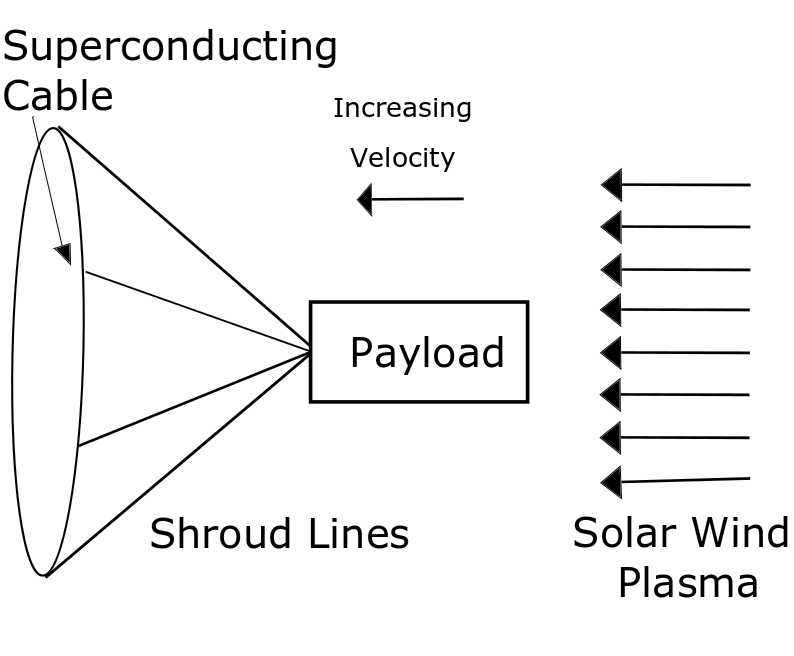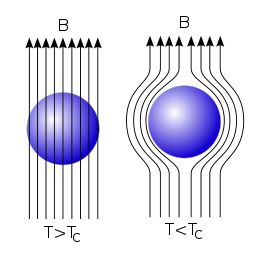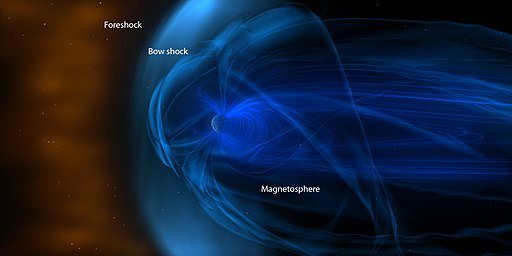Setting Sail in The Space - Part 3
We’ve been talking about sails in this series. And we've discussed electric and solar sails. Sails are a means of travelling in space that require no fuel or propellant to be carried on the spacecraft what so ever. Instead of carrying fuel from earth, sails gain whatever amount of speed they can from the space to travel in our solar system or even to go beyond it. In this part, we talk about The Magnetic Sails!!
Earlier Discussions :
Here are links to the earlier posts in which we talked about solar sails and electric sails. I'm describing them briefly here. You can read the posts too if you want.
Solar Sails:
Solar sail is a technology that harvests energy from the sunlight. The photons in the sunlight may have zero rest mass, but they have a non-zero momentum which is given by E/c (energy of photon / speed of light). These photons strike a mirror surface, transfer some of its momentum and are pushed backwards. And this is how solar sails gather momentum.
Electric Sails:
These sails gather energy from the plasma emitted from the sun, or a bit more simply, protons and electrons thrown out of sun at very high speeds. This plasma is called the Solar Wind, and is the driving force for Electric as well as Magnetic Sails. Electric sails that are being produced today are string that are positively charge so they could 1) deflect protons and 2) collect electrons so they could be pushed backwards using an electron gun to gain more acceleration in the forward direction.
All the sails use the principle of conservation of momentum to travel in space.
I'll tell you why we have this image of northern lights in this post in the end.
Magnetic Sails (or simply, magsails)
The concept of magnetic sails was proposed by Zubrin and Andrews in a paper published in 1988. Their design employed high temperature superconductors. Superconductors are materials that provide absolutely zero resistance below a certain temperature called critical temperature or transition temperature (Tc). If this temperature is low (close to 0 ⁰K), the material is a low temperature superconductor, and if it is considerably high, it is called high temperature superconductor ( Tc is more than or nearly that of liquid air, highest yet is 140 ⁰K. Graphene can be used as superconductor too, but more research is being done on this topic, let's wait and see what we come up with).
The property of superconductors being employed here is that if a magnet is brought close to the superconducting material, it expels the magnetic field of the magnet away from itself. This is called Meissner effect. The material kind of resists the magnet, causing it to levitate in the air above it.
This is just like same poles of magnets resisting each other, in this case, it's just that it doesn't matter which pole is facing the superconductor, the field lines will always be against each other.
The magnetic sail proposed by Zubrin and Andrews was simply a superconductor cable connected end to end (so it could form a circle), some equipment for maintaining a constant temperature, and some shroud lines as means of connecting all these to the spacecraft. The following image would give us a rough idea.

Once all this equipment is in space, we create the magnetic sail simply by
Setting it to a temperature lower than Tc
Having some current passed through it. This current applies a hoop stress over the superconductor cable, which then results in the cable being stretched out and forming a circular shape, that's it!!
Maintaining the temperature of the superconductor is an important factor since magnetic sail turns off if it gets even a bit hotter than Tc. Thankfully, we have high temperature superconductors which require neither much effort, nor much money for such maintenance.
Now, about the drawbacks, because they led us to seek newer ways of creating magnetic sails.
You see, magnetic sails function by creating a magnetic field that deflects the solar wind (plasma from the sun, as discussed earlier). And for achieving more acceleration, the field needs to be much stronger. But, this isn't the case with the fields created by superconductors. They are of the order of 10-6 T in this case.
Due to weak magnetic field, the size of the circle formed by our superconductor cable, needs to be enormous in order to generate a considerable thrust on the sail. This circle needs to have radius anywhere from 50 km to 150 km, depending on the mass of the payload. This seems a bit unreal. The electric sail being developed currently is a few thin wires 20 km long each.
Magnetic sail designs are quite efficient, but also fragile. One severe palsma eruption from the sun is enough to damage the sail.
These drawbacks made us search for better ways to create use magnetic field and solar wind for space travel, which led to the evolution of this concept into different designs. The one we are talking about in this post is Mini-Magnetospheric Plasma Propulsion (M2P2), which also has evolved further into magbeam and plasma magnet drive which are even more efficient. But for now, let's focus on M2P2.
Mini-Magnetospheric Plasma Propulsion (M2P2):
This idea was proposed by Robert Winglee. The very first term suggests that this kind of device creates what can be called a "mini-magnetosphere" around the magnet that we plan to use as a sail. Let's understand what we can from this.
Since we need to understand the magnetosphere first, let's have some Q&A about it...
What on earth is a magnetosphere?
First, it is a region above earth's surface. Second, this region is created by interaction between the earth's magnetic field and the solar wind plasma. The plasma being magnetized in nature, when it comes in contact with our earth's magnetic field, mostly gets deflected away from the earth. The first image in the post is aurora borealis or northern lights, which is actually a result of the interaction between solar wind and earth's plasma as seen from earth surface. This happens when the charged particles penetrate the magnetosphere and collide with particles in earth's atmosphere. Beautiful, isn't it?
How big is the magnetosphere?
Well, on average, it stretches out to ten times the radius of earth. And the solar wind plasma has a big role in this. Because this plasma in the magnetosphere is solely responsible for the magnetic field of earth being stretched so far out...
Why on earth is the magnetosphere so huge?
That would require some knowledge of plasma physics. More importantly, we need to see how the magnetized plasma behaves in a magnetic field.
If put in the simplest way that I've found the scientists explaining it, the magnetized plasma and the magnetic field together act a bit like an elastic string. If the plasma travels away from the magnetic field, it gets pulled back by the field. This results in constant motion of the plasma particle. This motion is very random (chaotic won't be an understatement). And this constant turbulence in the plasma is what results in the increase or inflation of the magnetic field.
This increase can also be seen as if the magnetic field is a balloon and magnetized plasma is the air being blown into it.
This applies the same principle that we see when we pass a current through a wire (electrons moving in almost the same direction) which results in a magnetic field being set up around it. In this case too, the paths traced by of electrons are quite random.
Now that we have discussed the magnetosphere, let's see what more we get to learn about M2P2...
Creating a small magnetosphere makes more sense now. We just need a strong magnetic field (a powerful enough electromagnet will do), and we inject some plasma in it. Then we magnetize the plasma and it's ready to move (randomly) in the field, thus inflating it.
This inflated magnetic field is powerful enough, and spreads over 30 km in diameter which is more realistic than a 100 to 300 km diameter required by a traditional magnetic sail.
One more thing to add to our theory, the solar wind plasma outside the magnetic field actually limits this inflation. So in case the M2P2 device is out of the solar system where plasma is less dense, the magnetic field increases further, thus maintaining the constant acceleration in any case.
We can tack against the direction of solar wind using M2P2, since deflecting the solar wind plasma can be controlled to some extent. This means we can travel towards as well as away from a sun or a star (which just a distant sun as it has it's own solar system).
M2P2 is not a sail. It uses plasma as a fuel. Mostly, inert gases like Argon and Xenon are preferred to be heated by radio frequency waves (same as microwave, the more the frequency of photons, the more their energy, and hence more the energy they impart to the electrons and nuclei of atoms when they collide with them, resulting in freeing of electrons from atoms, thus ionizing the inert gas, thus resulting in formation of plasma of electrons and positive ions.
One more thing I forgot to add. I think it is an important point that marks the difference between a magsail and it's evolved versions. A magsail can't protect the spacecraft from the damage that would be caused by the solar wind in the interplanetary and interstellar missions. But a small magnetosphere does protect the spacecraft to some useful extent, making the journey a more safe for the astronauts who deal with the harmful radiations that the outer space offers in abundance.
There are a lot more details in this topic which I have left out for the sake of keeping things simple. Hope you guys enjoyed it. Questions are most welcome. I’ll talk about the magbeam and plasma magnet in the next post in this series.
See ya'll later. Take care.
References:
- https://en.wikipedia.org/wiki/Magnetic_sail
- www.esa.int/Education/Magnetic_sails
- "Progress in Magnetic Sails" published in 1990 by Dana Andrews, more recent papers by Zubrin and Andrews are more about calculations regarding magsails than the theory, you can refer to them as well if you wish.
- https://en.wikipedia.org/wiki/Magnetosphere
- https://www.nasa.gov/mission_pages/sunearth/multimedia/magnetosphere.html
- earthweb.ess.washington.edu/space/M2P2/
- "Mini-Magnetospheric Plasma Propulsion (M2P2): High Speed Propulsion Sailing the Solar Wind" by Robert Winglee, John Slough, Tim Ziemba, and Anthony Goodson.



Being A SteemStem Member
No references for this?
Sorry, I thought I gave the references. I'll update it soon. Thanks for pointing it out.
I updated the references as soon as I could @mobbs. I think these are sufficient for those who are a bit more curious about magsails and M2P2.
Interesting one @pratik27
Its one of my dream to visit space, I dont know whether it will happen or not but I'll be buying a telescope in near future.....
Thank you @vinamra. Hope you do visit space sometime. Hotels in space, and a base on moon are being planned. Hope we get to visit those too!! Also perhaps a trip to mars, and if possible, Saturn's moons as well.
Great post. It doesn't seem like you are getting the likes it deserves though. Have you checked out the upvote communities? You should check out steemengine. or steemfollower.com.
Thank you @jehovahwitness. In my experience, I think a steemstem upvote is good, fair, and unbiased. It would be a waste of my time to go anywhere else looking for upvotes, lol.